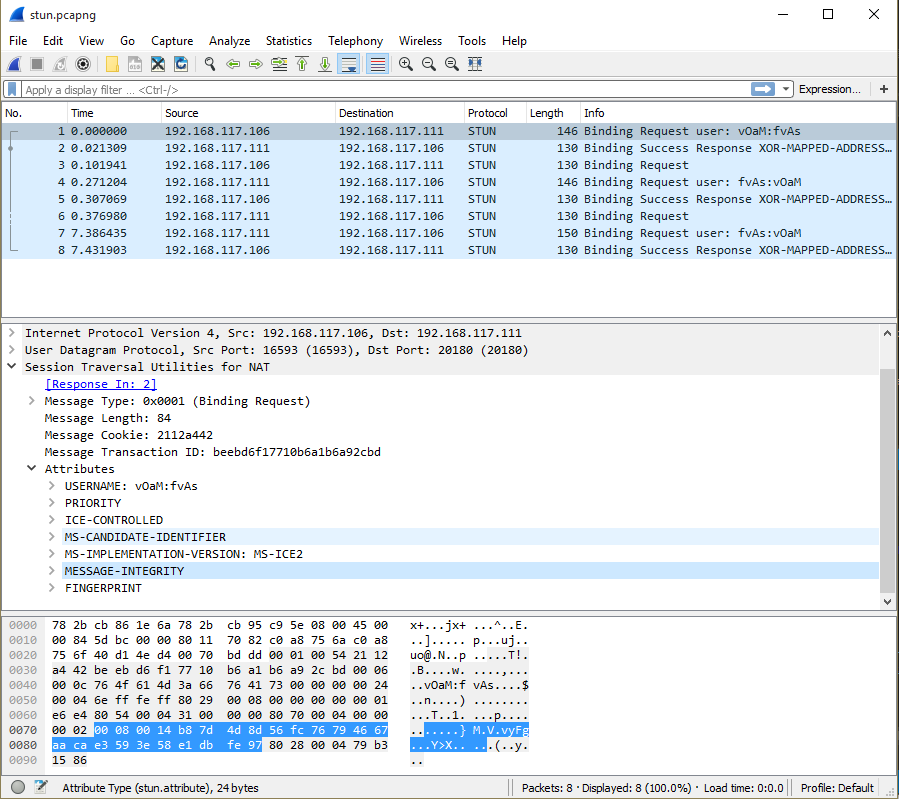Verifying STUN Message Integrity for Lync and Skype for Business ICE Traffic
Verifying STUN Message Integrity for Lync and Skype for Business ICE Traffic
Recently there have been some inquiries about how to verify the integrity of messages in STUN protocol conversations when used by Lync and Skype for Business. In this blog post, I will describe a common scenario based on a recent customer inquiry and explain how it was resolved.
Background
Interactive Connectivity Establishment (ICE)1 is a protocol that allows endpoints to create a media based connection across multiple networks where NAT is used. ICE makes use of STUN2 (Simple Traversal of UDP through NAT) and TURN3 (Traversal Using Relay NAT), two solutions to finding the internal addresses of remote endpoints when NAT is involved. Also useful in this discussion is the fact that the Open
Specifications include Microsoft’s extensions to ICE, namely the [MS-ICE], [MS-ICE2] and [MS-ICE2BWM] documents. We will reference [MS-ICE2]4 in this discussion.
Scenario
In this scenario, two Lync endpoints have established a connection via the ICE protocol and are in the process of connectivity checks per STUN. As part of the Binding Request message, an attribute is included called the MESSAGE-INTEGRITY. This contains an HMAC-SHA15 hash of the message called an HMAC.
In the network trace for this scenario, the STUN Binding Requests are being sent, having already shared the temporary username and password in previous Shared Secret Request.
Figure 1 MESSAGE-INTEGRITY Attribute
The calculation of the MESSAGE-INTEGRITY attribute is described in section 10.2.8 of the referenced STUN RFC. The HMAC-SHA1represents a hash of the message up to but not including the MESSAGE-INTEGRITY attribute itself.
To manually test this out, you can compute an HMAC using the jsSHA6 tool. Following the description in STUN 10.2.8, an overview of the steps:
- Copy the message data from your network analysis tool as a hex stream from the beginning of the STUN Binding Request message to just before the MESSAGE-INTEGRITY attribute. Insert this into the “Input Text:” field of the HMAC Demo section in the jsSHA tool. Remember to pad the text with 0’s to make up the 64-byte multiple length. Set the Input Type to HEX
- Provide the Key from the previous Shared Secret Request (not included in this explanation)
- Set the Key Type to TEXT
- SHA Variant should be SHA-1 and Output Type should be HEX
The resulting Output Hash field will update automatically and should match the value in the MESSAGE-INTEGRITY attribute.
In the above shown packet in figure 1, the text used to compute the HMAC is:
0x0000 000100542112A442
0x0008 BEEBD6F17710B6A1
0x0010 B6A92CBD0006000C
0x0018 764F614D3A667641
0x0020 7300000000240004
0x0028 6EFFFEFF80290008
0x0030 000000000001E6E4
0x0038 8054000431000000
0x0040 8070000400000002 <= stop just before the MESSAGE-INTEGRITY attribute
0x0048 0000000000000000 <= added 56 bytes of 0’s from here to the end
0x0050 0000000000000000
0x0058 0000000000000000
0x0060 0000000000000000
0x0068 0000000000000000
0x0070 0000000000000000
0x0078 0000000000000000
The total length of this is 0x80 hex or 128 bytes. The key from the Shared Secret Request for this conversation was:
ydYldnHIRgbOUr1MYUGy4t0g
Given this data and the steps above, you can even verify the resulting HMAC yourself by using the jsSHA tool. What you should see as a result is:
b87d4d8d56fc76794667aacae3593e58e1dbfe97
which matches the one in your trace.
However, in the customer scenario, for them it wasn’t matching.
Problem and Resolution
The problem in this scenario was that the MESSAGE-INTEGRITY HMAC hash value was not comparing correctly with the value computed using the shared key and message data.
The customer in this scenario was following the newer STUN draft RFC (https://tools.ietf.org/html/draft-ietf-behave-rfc3489bis-08\#section-14.4) which adds some verbiage to the message integrity validation process, specifically:
“Based on the rules above, the hash includes the length field from the STUN message header. This length indicates the length of the entire message, including the MESSAGE-INTEGRITY attribute itself. Consequently, the MESSAGE-INTEGRITY attribute MUST be inserted into the message (with dummy content) prior to the computation of the integrity check. Once the computation is performed, the value of the attribute can be filled in. This ensures the length has the correct value when the hash is performed. Similarly, when validating the MESSAGE-INTEGRITY, the length field should be adjusted to point to the end of the MESSAGE-INTEGRITY attribute prior to calculating the HMAC. Such adjustment is necessary when attributes, such as FINTERPRINT, appear after MESSAGE-INTEGRITY.”
This is not in the old (obsoleted) STUN RFC (https://tools.ietf.org/html/draft-ietf-behave-rfc3489bis-02#section-10.2.8). The problem is that the Lync processing is using the older RFC for the MESSAGE-INTEGRITY attribute and doesn’t include specifically the modification of the length in the message header before calculating the HMAC. The [MS-ICE2] open specification does reference the correct STUN RFC (i.e. the old one) in 2.2.2 but references (indirectly via ICE/NAT RFC1 ) the newer one in 3.1.4.8.2.4 where it speaks directly about calculating the MESSAGE-INTEGRITY attribute.
So, the only change to make to get the correct result, was to stop modifying the length field in the message header before calculating the HMAC.
The main take away from this exercise is that Lync uses the original STUN RFC for MESSAGE-INTEGRITY. It’s important to take note of the references provided in the Microsoft Open Specifications when parsing or coding to a protocol that is used by a Microsoft product. In this case [MS-ICE2] was misleading as it referred to the older STUN in 2.2.2 and the newer one (indirectly) in 3.1.4.8.2.4.
References
- ICE: https://tools.ietf.org/html/draft-ietf-mmusic-ice-19
- STUN: https://tools.ietf.org/html/draft-ietf-behave-rfc3489bis-02
- New STUN: https://tools.ietf.org/html/draft-ietf-behave-rfc3489bis-08
- TURN: https://tools.ietf.org/html/draft-rosenberg-midcom-turn-08
- [MS-ICE2]: https://msdn.microsoft.com/en-us/library/dd907518(v=office.12).aspx
- HMAC-SHA1: https://tools.ietf.org/html/rfc2104
